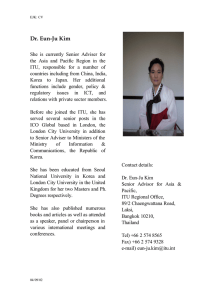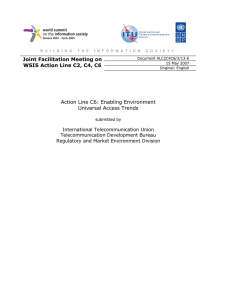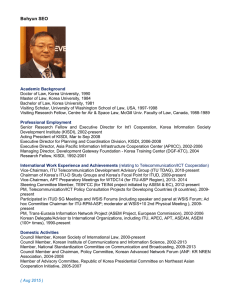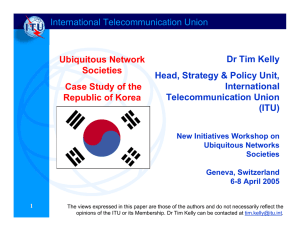Broadband Korea: Case study summary Tim Kelly Michael Minges
advertisement
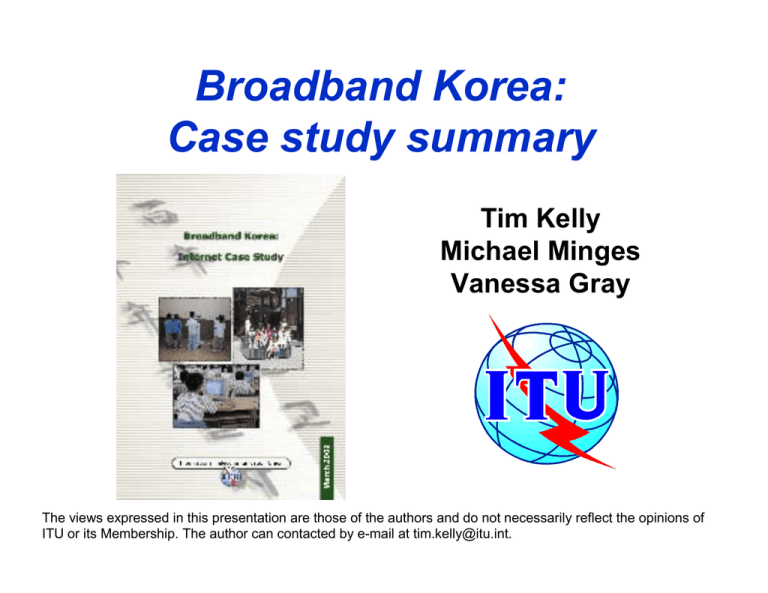
Broadband Korea: Case study summary Tim Kelly Michael Minges Vanessa Gray The views expressed in this presentation are those of the authors and do not necessarily reflect the opinions of ITU or its Membership. The author can contacted by e-mail at tim.kelly@itu.int. International Telecommunication Union Korea: #1 worldwide in broadband Korea (Rep.) 21.3 HK, China 14.6 Canada 11.5 Taiwan, China 9.4 Iceland 8.7 Denmark 8.6 Belgium 8.4 Sweden Source: ITU World Telecom Indicators Database. 2 Broadband subscribers per 100 inhabitants, by technology, 2002 7.7 Austria 6.6 Netherlands 6.5 United States 6.5 Switzerland 6.3 Japan 6.1 Singapore 5.5 Finland 5.3 DSL Cable Other International Telecommunication Union Just how far ahead is Korea? Broadband subscribers, end 2002, million 12 10.1m 10.7m 10 Denmark, Italy, Finland, Portugal, Spain, Ireland, Lux & Greece Austria Sweden 8 Belgium Netherlands 6 UK Source: ITU World Telecom Indicators Database. 3 4 France 2 Germany 0 Rep. of Korea, Population 47 m European Union, Population 380 m International Telecommunication Union Secrets of Korea’s success (1) Government policy push Maximise ability of all citizens to use ICTs Vision of a creative knowledgebased society CYBER KOREA 21 (1999-2002) Ten priority areas Annual action plans National Framework Plan for Informatization Promotion (1996-2000) National information superhighway Korea Information Infrastructure Initiative (1995-2005) Administration, defence, public security, finance & education 4 E-Korea Vision 2006 (2002-2006) Focus on manufacturing National Basic Information System (1987 – 1996) Measures to nurture IT Industry (1987 – 1985) Outcome of public policy drive: A highly ICT-literate society ! Home PC-ownership: >78%, of which >86% are Internet users ! >90% of Internet users have broadband access PC Penetration at home (78.5%) Internet Access at home (68.1%) Year Other No Internet Access No PC at home Dial-up ISDN xDSL Cable modem June 2002 3.0% 0.5% 55.5% 8.8% 0.3% 10.4% 21.5% Dec 2001 5.5% 0.8% 45.1% 11.3% 0.5% 13.6% 23.1% Source: Adapted from KRNIC. International Telecommunication Union Secrets of Korea’s success (2) Infrastructure competition 26,270 Internet users (in thousands) 24,380 More than 18’000 ICT companies are active in the Korean market 19,040 10,860 3,103 731 1996 ADSL market entry of Hanaro Telecom 1,643 1997 6 Source: Adapted from KRNIC. 1998 1999 2000 2001 2002 Outcome of infrastructure competition: Diversity and choice Broadband service penetration (in ‘000s of subscribers) Technology Max. Down Speed xDSL Up to 8Mbit/s 1999 2000 2001 Nov. 2002 1 170 2’070 4’387 5’664 Up to 10Mbit/s 13 190 1’390 2’530 3’554 Up to 10Mbit/s - - 540 875 1’181 Up to 1Mbit/s - 10 20 12 6 Total Subscribers (‘000s) 14 370 4’020 7’805 10’405 % of total household 0.1% 2.6% 29% 56% 63% Cable modem Metro Ethernet & B-WLL Satellite 1998 Source: Adapted from Korean Ministry of Information and Communications. International Telecommunication Union Secrets of Korea’s success (3) Attractive pricing options SwissCom (Bluewin) 139.00 Iceland (Islandssimmi) 72.60 Canada (Bell Sympatico) 30.60 US (Comcast) 28.60 Singapore HK, China (PCCW) 21.90 12.70 Korea (Hanaro/KT) 2.90 Japan (Yahoo BB) 1.80 8 Source: ITU research. Price per 1 Mbit/s, April 2003 International Telecommunication Union Outcome of lower prices: Higher spending on ICT services 6% 5% Korea (Rep.) 4% Hong Kong SAR 3% Global average 2% Telecom spending as a % of national GDP 1% 0% 9 1991 Source: ITU World Telecommunication Indicators Database. 2001 International Telecommunication Union More secrets of Korea’s success ! Emphasis on education " Broadband seen as family investment in education ! Highly-urbanized population " 80% living in urbanized areas " 48% of housing stock is apartment blocks ! Favourable regulatory environment " Local loop unbundling " Government support for facilities-based competition ! Local manufacturing and local content " Emphasis on R&D " High performance IP backbone " Korean content (e.g., DAUM website) and games ! Government support 10 " Spectrum fees and other remain within sector
